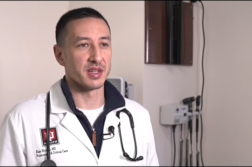COLUMBUS, Ohio (Ivanhoe Newswire) – Lung cancer is the second most common cancer in the United States in both men and women. One hundred twenty-seven thousand people will die from it this year. It’s often caught in a later stage but when doctors detect it early, it can be cured. Researchers are now looking at a program – using artificial intelligence – to catch the tiniest cancers that might be easy to miss.
Steven Porter is his family’s historian, curating old photos and tracing his roots on genealogy websites. Porter says there’s no history of cancer in his family but as a former smoker, his doctor advised him to get screened.
“In 2022, I went and that’s when they found the solid nodule. They took enough of it during the biopsy that they knew they had it all,” Porter recalls.
Porter knows he’s lucky and he’s in the minority. Only six percent of all Americans eligible for lung cancer screening with a low-dose CT scan actually get it done. But now, there’s a new program to detect tiny lung spots, or nodules that might otherwise go undetected.
Ohio State researchers and clinicians have created a system to evaluate all CT scans, not just those of lung cancer patients.
“If they’ve had a heart attack, if they’ve had a motor vehicle or accident. If they’ve had a pneumonia and they undergo a CT scan,” explains Ohio State Wexner Medical Center interventional pulmonologist, Jasleen Pannu, MD.
The team uses automated natural language processing tools – artificial intelligence – to evaluate written radiology reports.
Dr. Pannu further explains. “If there is a radiologist that has reported a lung nodule of a certain size, these can be flagged and followed up.”
Dr. Pannu says when nodules are detected unexpectedly, the patient’s CT scan is further evaluated so they won’t fall through the cracks. Steven Porter’s screening was scheduled but either way, he knows the importance of catching the cancer early.
Dr. Pannu says at Ohio State alone, 1,000 new, early-stage cancers could be caught by screening lung nodules found unexpectedly. She says when patients come into the hospital for emergency treatment and undergo CT scans, tiny nodules can be overlooked because the medical team is focused on the emergency at hand.
Contributors to this news report include: Cyndy McGrath, Producer; Kirk Manson, Videographer; Roque Correa, Editor.
To receive a free weekly e-mail on medical breakthroughs from Ivanhoe, sign up at: http://www.ivanhoe.com/ftk
Sources:
https://www.cancer.org/cancer/lung-cancer/about/key-statistics.html
American Lung Association
https://www.lung.org/media/press-releases/state-of-lung-cancer-2022
MEDICAL BREAKTHROUGHS
RESEARCH SUMMARY
TOPIC: LUNG CANCER: USING AI TO MAKE A CRITICAL CATCH!
REPORT: MB #5188
BACKGROUND: Lung cancer is the second most common form of cancer in the United States and averages around 238,000 new cases every year. About 127,000 cases are fatal and it remains the leading cause of death in the United Sates. Lung cancer is a type of cancer that starts in the lungs. The symptoms of lung cancer can be subtle and often not noticeable until the disease is advanced. Early detection of lung cancer is critical for improving patient outcomes and increasing the likelihood of successful treatment. While most cases arise in elderly people, anyone of any age can be affected. Survival rates regarding lung cancer vary amongst the type and stage of the disease.
(Source:
https://www.cancer.org/cancer/lung-cancer/about/key-statistics.html
DIAGNOSING: Diagnosing lung cancer involves a combination of medical tests and procedures that are designed to identify the presence of abnormal cells in the lungs. Early diagnosis is crucial for effective treatment and improved outcomes, so it is important to be aware of the signs and symptoms of lung cancer and to seek medical attention promptly if you experience any of them. Lung cancer has two main types, small cell lung cancer and non-small cell lung cancer. Risk factors can include smoking, secondhand smoke, radon gas released, family history, chronic lung diseases, radiation, and diesel exhaust. The most common methos of testing for the disease include, chest x rays, chest CTs, bronchoscopy, and sputum cytology.
(Source:
NEW TECHNOLOGY: Artificial Intelligence (AI) has the potential to play a significant role in the early detection and diagnosis of lung cancer. AI algorithms can analyze large amounts of medical data, including medical images such as CT scans, and help identify patterns that may indicate the presence of cancer. This can help doctors detect lung cancer at an early stage, when it is more treatable. Ohio State University researchers and doctors have created a method to evaluate CT scans through artificial intelligence that look at written radiology reports. This has the ability to look at all CT scans and not just those of lung cancer.
(Source:
FOR MORE INFORMATION ON THIS REPORT, PLEASE CONTACT:
Amanda Harper
If this story or any other Ivanhoe story has impacted your life or prompted you or someone you know to seek or change treatments, please let us know by contacting Marjorie Bekaert Thomas at mthomas@ivanhoe.com




